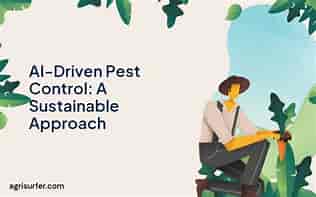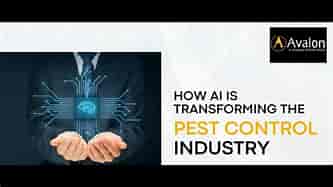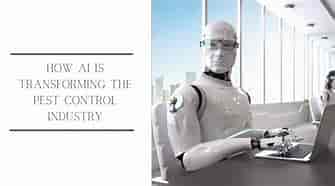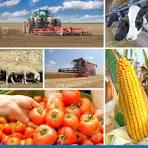Introduction
Pest control has always been a challenge for farmers and agriculturalists. Traditional methods often rely heavily on chemical pesticides, which can harm the environment and human health. But what if there was a way to manage pests more effectively and sustainably? Enter artificial intelligence (AI). This technology is not just a buzzword; it’s transforming how we approach pest management. Imagine having a smart assistant that can predict pest outbreaks, recommend targeted treatments, and minimize chemical use. Sounds intriguing, right? Let’s dive into how AI is shaping the future of sustainable pest control.
Understanding Sustainable Pest Control
What Is Sustainable Pest Control?
Sustainable pest control refers to strategies that manage pest populations while minimizing environmental impact. This approach emphasizes the use of natural predators, habitat manipulation, and organic solutions over synthetic chemicals. The goal is to maintain ecological balance while protecting crops.

Why Is Sustainability Important?
With the growing concerns about climate change and biodiversity loss, sustainable practices are essential for preserving our planet. By adopting sustainable pest control methods, we can reduce chemical runoff into waterways, protect beneficial insects, and promote healthier ecosystems.
The Role of AI in Pest Control
How Does AI Work?
AI involves using algorithms and machine learning to analyze data, recognize patterns, and make predictions. In the context of pest control, AI can process vast amounts of information from various sources—like weather patterns, crop health data, and historical pest outbreaks—to provide actionable insights.
Benefits of Using AI in Pest Management
- Precision: AI allows for targeted interventions rather than blanket pesticide applications.
- Efficiency: Automated systems can monitor fields continuously, reducing labor costs.
- Predictive Analytics: AI can forecast pest outbreaks before they occur, allowing for proactive measures.
Applications of AI in Sustainable Pest Control
1. Early Detection Systems
One of the most significant advantages of AI is its ability to detect pests early. Using image recognition technology, farmers can identify pests through photos taken by drones or smartphones.
How It Works
- Image Recognition: AI algorithms analyze images to identify specific pests or signs of infestation.
- Alerts: Farmers receive real-time alerts when pests are detected, enabling quick action.
2. Predictive Modeling
AI can analyze historical data to predict future pest outbreaks based on environmental conditions.
Benefits of Predictive Modeling
- Resource Allocation: Farmers can allocate resources more efficiently by knowing when to expect pest pressures.
- Reduced Chemical Use: By predicting outbreaks, farmers can apply treatments only when necessary.
3. Integrated Pest Management (IPM)
AI supports IPM strategies by providing data-driven recommendations for pest control methods that combine biological, cultural, physical, and chemical tools.

Components of IPM Supported by AI
- Monitoring: Continuous data collection on pest populations.
- Decision Support: AI-driven recommendations help farmers choose the best management practices.
4. Smart Traps
Smart traps equipped with sensors and AI can monitor pest populations in real time.
How Smart Traps Work
- Data Collection: Traps collect data on pest activity.
- Analysis: The data is analyzed using AI to determine population trends and inform control strategies.
Case Studies: AI in Action
Case Study 1: Precision Agriculture with Drones
In a recent study, farmers used drones equipped with AI technology to monitor crop health and detect pests. The drones provided high-resolution images that allowed for precise identification of problem areas. As a result, farmers reduced pesticide use by 30% while maintaining crop yields.
Case Study 2: Predictive Analytics in Cotton Farming
A cotton farm implemented an AI system that analyzed weather patterns and historical infestation data. The system predicted peak pest activity periods accurately, enabling the farmer to apply targeted treatments only when necessary. This approach led to a significant decrease in pesticide application and improved overall crop health.
Challenges in Implementing AI for Pest Control
Data Quality and Availability
For AI systems to be effective, they require high-quality data. In many regions, farmers may lack access to comprehensive datasets about pests or environmental conditions.
Cost of Technology
While the long-term benefits of using AI are clear, the initial investment in technology can be a barrier for small-scale farmers.
Training and Knowledge Gaps
Farmers need training to effectively use AI tools and interpret the data provided. Bridging this knowledge gap is crucial for successful implementation.
The Future of AI in Sustainable Pest Control
Innovations on the Horizon
As technology continues to evolve, we can expect even more sophisticated applications of AI in pest management:
- Machine Learning Enhancements: Improved algorithms will lead to better predictions and recommendations.
- Integration with IoT Devices: Smart sensors will provide real-time data directly from fields.
- Collaboration Platforms: Farmers will be able to share data and insights globally, enhancing collective knowledge about pest management.
A Collaborative Approach
The future of sustainable pest control lies in collaboration between technologists, agronomists, and farmers. By working together, they can develop tailored solutions that meet local needs while promoting sustainability.

Conclusion
AI is revolutionizing sustainable pest control strategies by providing innovative tools that enhance efficiency and reduce environmental impact. From early detection systems to predictive modeling and smart traps, the applications are vast and varied. While challenges remain—such as data quality and cost—overcoming these hurdles will pave the way for a more sustainable agricultural future. As we embrace these technologies, we move closer to a world where farming is not only productive but also environmentally responsible.
FAQs About AI in Sustainable Pest Control
1: How does AI improve early detection of pests?
AI uses image recognition technology to analyze photos taken by drones or smartphones, identifying pests quickly so that farmers can take immediate action.
2: What is Integrated Pest Management (IPM)?
IPM is a holistic approach that combines biological, cultural, physical, and chemical methods for managing pests sustainably; AI enhances this by providing data-driven recommendations.
3: Can small-scale farmers afford AI technology?
While initial costs may be high, many solutions are becoming more affordable over time; additionally, the long-term savings from reduced pesticide use can offset these costs.
4: What role do smart traps play in pest management?
Smart traps equipped with sensors collect real-time data on pest populations; this information is analyzed using AI to inform control strategies effectively.
5: How does predictive modeling benefit farmers?
Predictive modeling helps farmers anticipate pest outbreaks based on historical data and environmental conditions; this enables them to apply treatments only when necessary.

